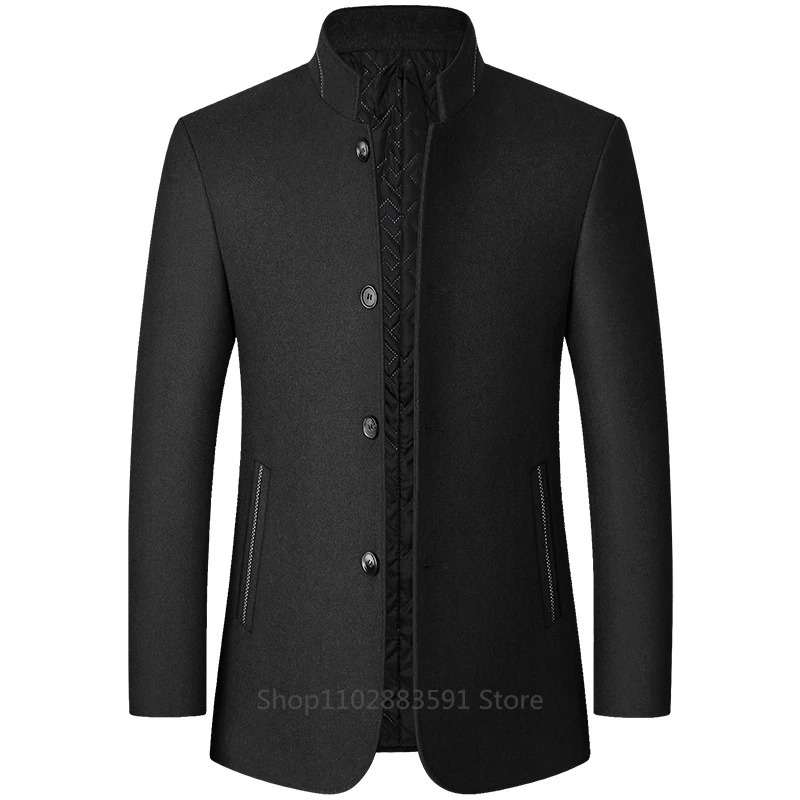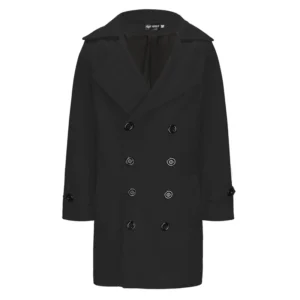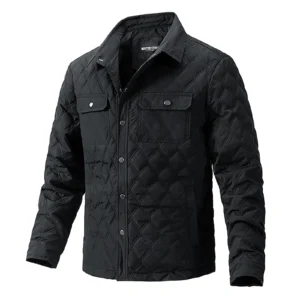Understanding Coat Length Fundamentals
The length of your coat does far more than simply determine how much of your body stays warm. It fundamentally shapes your overall appearance, creating visual balance and enhancing your natural proportions. When selected thoughtfully, the right coat length can elevate your entire look, making you appear taller, more polished, or more relaxed depending on your needs.
Beyond aesthetics, coat length directly impacts functionality. A longer coat provides superior protection against harsh weather elements, while shorter styles offer greater mobility and comfort during active situations. The choosing right coat length also carries significant social messaging – longer coats traditionally signal formality and sophistication, while shorter options tend to read as more casual and approachable.
Proper coat length also serves as a foundation for effective layering. When balanced correctly with underlying garments, your coat creates a cohesive silhouette that appears intentional and well-considered rather than haphazard or poorly fitted.
Understanding these fundamentals empowers you to make confident selections that enhance both your appearance and comfort, ensuring your outerwear works harmoniously with your unique physique and personal style.
How to Measure Coat Length Correctly
Taking accurate coat measurements ensures a flattering fit that enhances your proportions. Follow these straightforward steps to measure coat length properly:
For measuring existing coats:
* Lay the coat flat on a surface, ensuring the back is completely smooth
* Place your measuring tape at the center base of the collar (not including any collar that folds down)
* Measure straight down to the bottom hem of the coat
* Record this measurement as the “center back length”
For determining your ideal coat length:
* Stand straight in front of a mirror
* Identify key reference points on your body: knuckles (for short coats), mid-thigh, knee, and mid-calf
* Consider these points in relation to your overall height and build
The perfect coat length for height varies significantly between individuals. While industry measurements typically reference the center back length, remember that your perceived coat length will also be influenced by your proportions, posture, and how the coat hangs on your frame.
Essential Coat Length Terminology
Understanding common coat length terminology helps you navigate shopping and tailoring with confidence:
Short Lengths:
* Waist length – Ends at or just below your natural waistline, typically hitting around the belt line
* Hip length – Extends to cover the hips, ending approximately where your wrist falls when standing naturally
Mid Lengths:
* Thigh length – Reaches to mid-thigh, offering balance between protection and mobility
* Three-quarter length – Falls between mid-thigh and the knee, a versatile length for many coat styles
Long Lengths:
* Knee length – Hits exactly at the knee joint, the standard length for many traditional overcoats
* Below-knee – Extends several inches past the knee, providing additional coverage while maintaining mobility
* Full length – Reaches to mid-calf or beyond, offering maximum protection and formal appearance
These standardized terms are invaluable when comparing short vs. long coats and communicating effectively with retailers or tailors about your preferences. The terminology also helps you understand historical context and traditional expectations for different coat styles.
Overcoat Length Guide
The classic overcoat represents the pinnacle of men’s outerwear formality, with its length playing a crucial role in both its functionality and visual impact.
Full-Length Overcoats (Mid-calf to Ankle)
* Provides maximum protection against cold weather and wind
* Creates a commanding, formal silhouette ideal for business formal and evening occasions
* Pairs exceptionally well with suits and formal attire
* Traditionally considered the most elegant and refined option
* Best suited for taller men (over 5‘10”/178cm) to maintain balanced proportions
Three-Quarter Length Overcoats (Mid-thigh to Knee)
* Offers the most versatile wearing options across both formal and smart-casual settings
* Provides good weather protection while maintaining ease of movement
* Creates a clean silhouette that works well with most body types
* Balances traditional appearance with modern sensibilities
* Appropriate for business settings without appearing overly formal
Knee-Length Overcoats
* Represents the modern standard for most overcoat styles
* Provides sufficient coverage for suits and formal wear
* Flatters most heights and builds when properly tailored
* Transitions well between professional and casual contexts
* Strikes an ideal balance between protection and mobility
Metro Cloak’s collection of mens overcoats showcases these different length options, allowing you to select the perfect proportion for your needs. The key to selecting the right overcoat length lies in balancing your natural proportions with your intended use and personal style preferences.
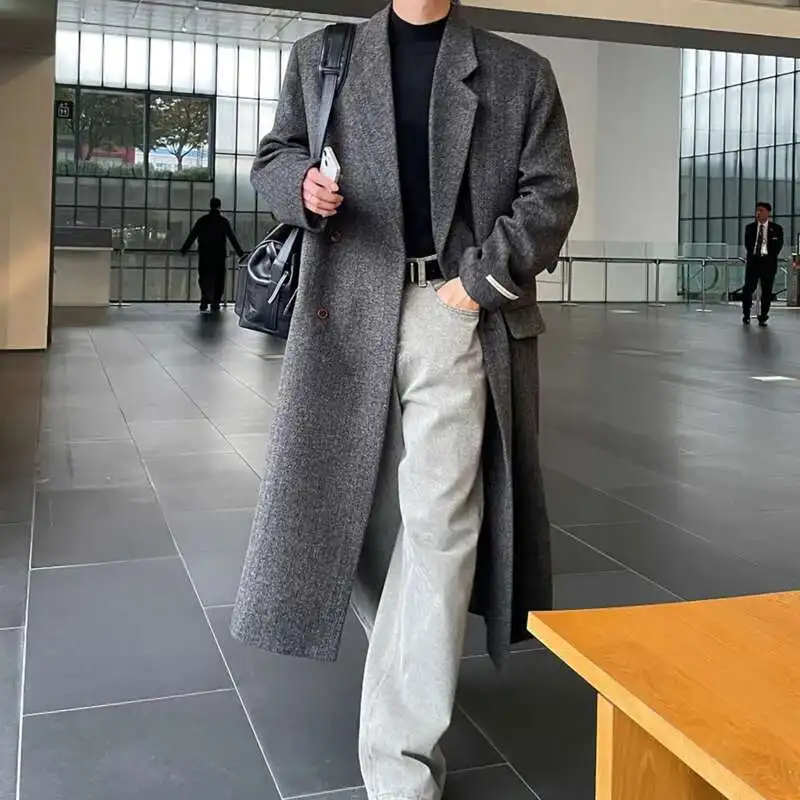
Trench Coat Length Considerations
The trench coat’s military heritage established specific length parameters that continue to influence modern designs. Originally developed as practical battle gear, the traditional trench coat extends to just below the knee, providing ample protection while allowing mobility.
Modern trench coats typically fall into two length categories:
Classic length (below knee): Creates the most authentic and formal appearance, ideal for professional settings and formal occasions. This length provides maximum rain protection and pairs exceptionally well with business attire.
Contemporary length (mid-thigh to knee): Offers a more versatile, casual option that works well in various settings. This modernized length provides greater ease of movement while maintaining the trench coat’s distinctive character.
The belt placement on a trench coat significantly affects its visual length. A higher belt position creates the appearance of longer legs and a shorter torso, while a lower belt does the opposite. For shorter men, a slightly higher belt placement often creates more flattering proportions.
For the most flattering fit, taller men (over 6’/183cm) generally benefit from mens long overcoat options that extend below the knee, while shorter men may prefer lengths that hit precisely at or slightly above the knee to maintain balanced proportions.
Pea Coat and Duffle Coat Lengths
These classic casual coats feature distinctive length profiles shaped by their functional origins and continue to be staples in men’s winter wardrobes.
Pea Coat Length:
* Traditional pea coats end at the hip or upper thigh, typically 30-32 inches (76-81cm) in total length
* This shorter length originated from naval needs – keeping the coat above sea spray while providing core warmth
* The compact length allows for easy movement while working on ships
* Modern interpretations sometimes extend to mid-thigh for additional warmth
* The double-breasted front maintains warmth despite the shorter length
Duffle Coat Length:
* Classic duffle coats typically reach mid-thigh to knee, measuring 34-38 inches (86-97cm) in total length
* The longer length provided additional protection for naval personnel in cold North Atlantic conditions
* Toggle closures were designed for easy operation with gloved hands
* Contemporary versions maintain this practical length for winter protection
* The straight cut accommodates layers underneath while maintaining mobility
Both coat styles balance practical protection with freedom of movement, making them excellent choices for active winter wear. Their distinctive lengths have become defining characteristics, with the mens pea coats length in particular being immediately recognizable as part of its iconic silhouette.
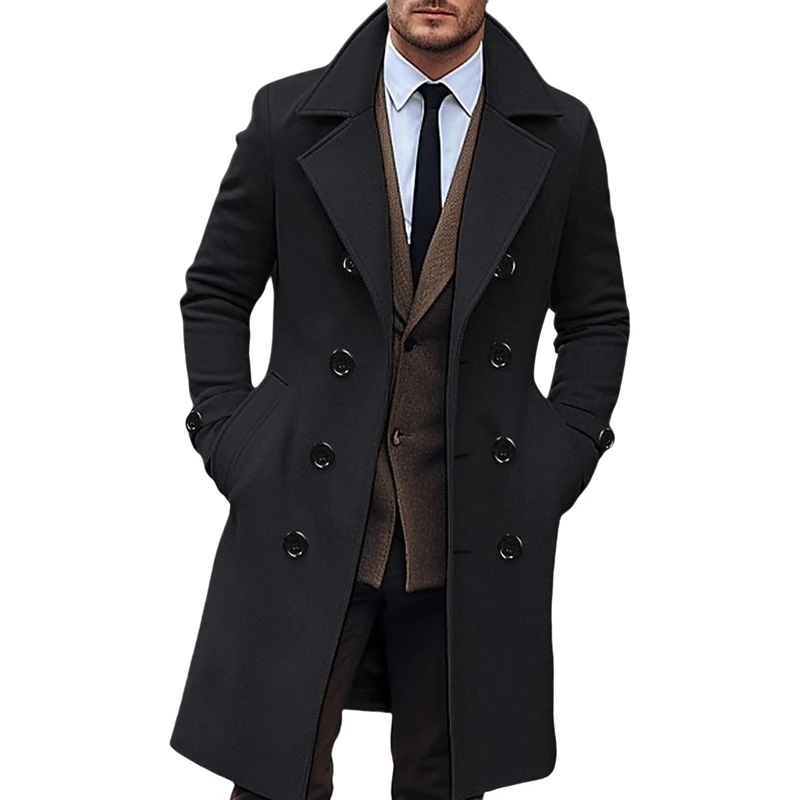
Car Coats and Utility Jacket Lengths
Designed with specific practical functions in mind, car coats and utility jackets feature lengths that prioritize both protection and mobility.
Car Coat Length:
* Traditionally extends to mid-thigh, typically 32-34 inches (81-86cm) in length
* Originally designed to provide adequate coverage while seated in automobiles
* Long enough to protect against drafts when sitting but short enough to prevent bunching
* Often features a straight cut that allows comfortable leg movement for driving
* Modern variations maintain this practical length while incorporating contemporary styling
Utility and Field Jacket Length:
* Typically ends at the hip or upper thigh, ranging from 28-32 inches (71-81cm)
* Designed for active outdoor work requiring significant movement
* Often includes a slight drop in the back hem for additional coverage when bending
* Features functional length that won’t interfere with leg movement or tool access
* Contemporary versions preserve this practical length while updating materials and details
The shorter length of these practical coats makes them excellent choices for daily wear in moderate weather conditions. Many mens car coats feature clean lines that maintain a smart appearance despite their more casual length, allowing them to transition easily between different settings.
Tailoring Coat Length to Your Body Type
Your physical proportions should significantly influence your coat length selections. Follow these guidelines to find the most flattering options for your body type:
For Shorter Men (5‘8”/173cm and under):
* Avoid full-length overcoats that may overwhelm your frame
* Select coats that end at mid-thigh or just above the knee
* Ensure the coat’s hem falls above mid-calf to maintain leg proportion
* Consider slightly higher waist positioning on belted coats
* Look for streamlined designs without excessive bulk or details
For Taller Men (6‘2”/188cm and above):
* Longer coats (knee-length and below) complement your height naturally
* Avoid extremely short jackets that may make limbs appear disproportionate
* Consider three-quarter or full-length overcoats for formal settings
* Look for designs with horizontal details to break up vertical lines
* Pay attention to sleeve length—ensure they reach the base of your thumb
For Slim Builds:
* Consider slightly longer coats to add visual weight to your frame
* Look for designs with some structure in the shoulders and chest
* Mid-thigh to knee-length options often provide the most balanced appearance
* Double-breasted styles can add perceived width to a narrow frame
For Broader Builds:
* Select coat lengths that hit at the most flattering point of your legs
* Consider single-breasted styles that create a cleaner vertical line
* Avoid extremely short or extremely long coats that emphasize width
* Look for clean, streamlined designs without excessive details
Finding the perfect coat length every body type involves balancing these principles with personal style preferences. Shorter men, in particular, benefit from understanding specific best coat length for short men guidelines to create balanced proportions.
Coat Length and Formality: Making the Right Choice
The length of your coat directly communicates its level of formality, with longer lengths generally signaling more formal occasions. Use this guide to select appropriate lengths for different settings:
| Occasion | Recommended Coat Lengths | Notes |
|---|---|---|
| Black Tie/Formal | Knee-length to full-length overcoats | Traditionally a full-length coat for maximum formality |
| Business Formal | Knee-length to below-knee overcoats | Clean lines and structured shoulders preferred |
| Business Casual | Mid-thigh to knee-length | Includes shorter overcoats, trench coats |
| Smart Casual | Hip to knee-length | Includes pea coats, car coats, shorter trench styles |
| Casual Outings | Hip to mid-thigh | Utility jackets, shorter car coats, casual parkas |
| Outdoor Activities | Hip to mid-thigh | Prioritizes freedom of movement |
Understanding these conventions allows you to make appropriate selections that demonstrate social awareness. The mens coat length style guide principles apply across various social contexts, though contemporary fashion increasingly permits some flexibility in these traditional rules.
When uncertain about the appropriate coat length for an occasion, it’s generally better to err slightly more formal (longer) than too casual (shorter), particularly for professional and evening events.
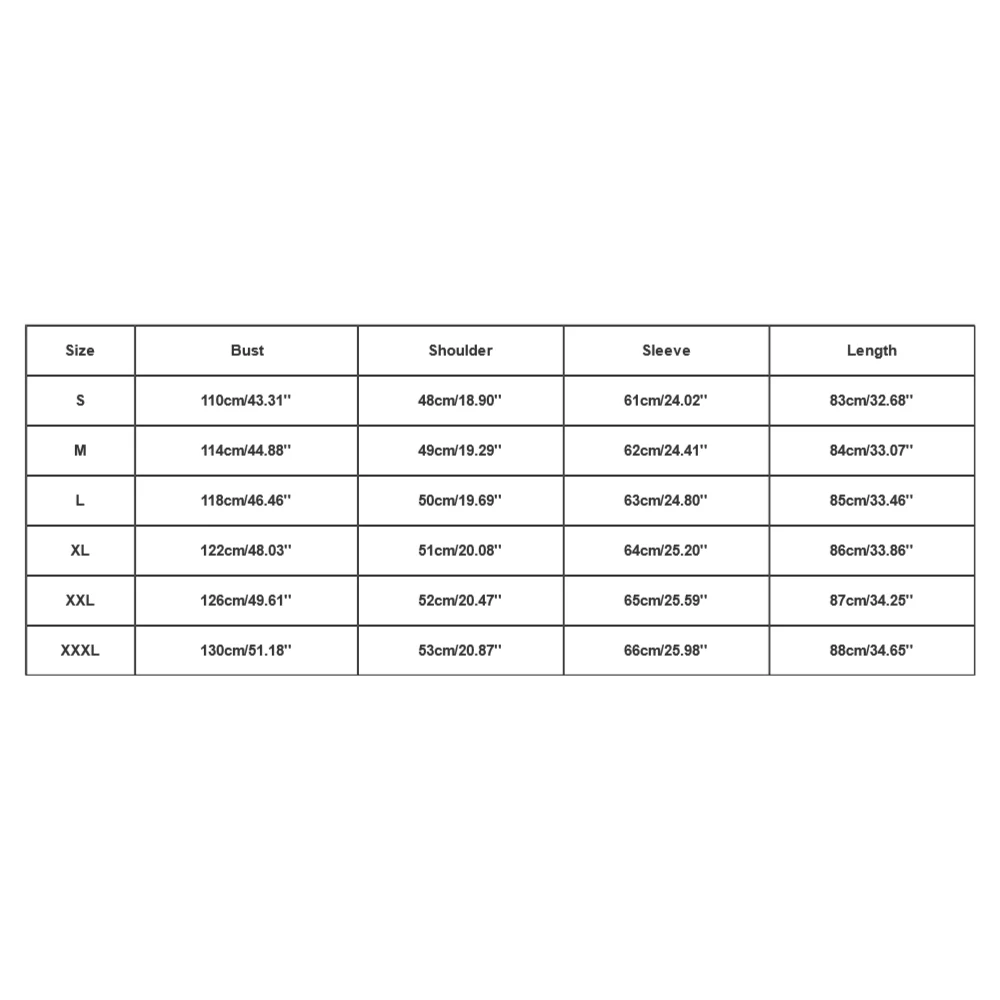
Layering Strategies: Coat Length and Underlying Garments
Effective layering requires careful consideration of how your coat length relates to your underlying garments. Follow these principles to create polished, proportional combinations:
For Suits and Blazers:
* Your overcoat should be long enough to fully cover your suit jacket or blazer
* Aim for at least 2-3 inches (5-7.5cm) of overcoat extending beyond your suit jacket hem
* For formal occasions, ensure your overcoat completely conceals your suit
* Avoid situations where your suit jacket visibly extends past your overcoat
For Casual Layers:
* The “peeking layers” rule can be applied more flexibly with casual outfits
* A slight show of a sweater or untucked shirt below a casual jacket can create visual interest
* Keep any visible under-layers to no more than 1-2 inches (2.5-5cm) for a deliberate look
* Ensure the fabrics and colors of visible layers complement each other
Technical Considerations:
* Thicker mid-layers require slightly longer and fuller-cut outer layers
* Account for how layers compress when measuring ideal coat length
* Consider mobility needs when determining coat length for layered outfits
* Ensure sleeve lengths graduate properly (inner layers slightly shorter than outer layers)
Mastering art layering grey wool coat creates a sophisticated appearance that works across various settings. Thoughtful attention to these proportional relationships significantly elevates your overall presentation.
Common Coat Length Mistakes to Avoid
Even small errors in coat length selection can significantly undermine your overall appearance. Be aware of these common pitfalls:
Problem: The “Too Short” Overcoat Over Formal Wear
When your overcoat fails to cover your suit jacket completely
Solution: Select overcoats that extend at least 2-3 inches beyond your longest suit jacket. This ensures a clean, intentional line and proper protection.
Problem: The “Drowning” Effect of Excessively Long Coats
When a coat’s length overwhelms your frame and makes you appear shorter
Solution: Choose coat lengths proportional to your height. For most men, avoid coats that extend below mid-calf, and consider shorter options if you’re under 5‘8” (173cm).
Problem: Ignoring Weather and Lifestyle Requirements
Selecting coat lengths based solely on aesthetics without considering practical needs
Solution: Balance style preferences with practical considerations like climate, commute method, and typical activities. A fashionable coat that leaves you exposed to the elements won’t serve you well.
Problem: Mismatching Coat Style and Length
Choosing non-traditional lengths for specific coat styles that disrupts their intended design
Solution: Respect the traditional length parameters of classic coat styles, making only minor adjustments to suit your proportions. Some coat styles simply don’t function well at drastically different lengths.
Understanding what length coat makes you taller helps avoid proportion mistakes that can visually shorten your frame. When in doubt, opt for lengths that end at a natural break point on your body (knee, mid-thigh) rather than at an awkward in-between position.
Is Your Coat Length Adjustable? Tailoring Possibilities
Q: Can coat length be professionally altered?
A: Yes, but with significant limitations. Most coats can be shortened by 2-4 inches (5-10cm) maximum, depending on construction. Lengthening is rarely possible beyond 1/2-inch (1.3cm) if any hem allowance exists.
Q: What determines if a coat can be shortened?
A: The coat’s design elements are crucial. Coats with vents, shaped hems, or decorative details near the bottom edge present complications. The presence of pockets near the hem can also limit alteration possibilities.
Q: How much does coat length alteration typically cost?
A: Shortening a coat generally costs between $75-150, depending on complexity, lining type, and local tailoring rates. More complex alterations involving vents or special hems may cost more.
Q: Is altering coat length worth the investment?
A: It’s worth considering for high-quality coats made from premium materials with good construction. The mens wool overcoat collection features pieces worth this investment, as their quality materials and craftsmanship justify the tailoring expense.
Q: What signs indicate a coat is worth tailoring?
A: Look for quality construction details like hand-stitching, premium materials, fully canvassed construction, and classic styling that won’t quickly become dated. These indicators suggest a garment worthy of alteration investment.
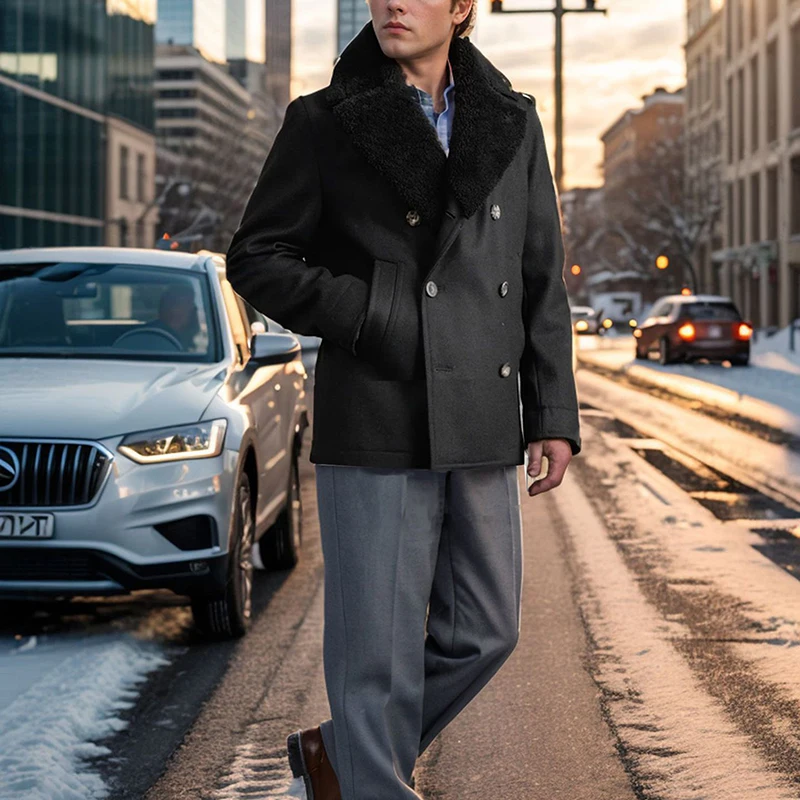
Mens Double Breasted Pea Coat, Mens Wool Blend Coat, Mens Wool Pea Coat
Price range: $136.84 through $157.36 Select options This product has multiple variants. The options may be chosen on the product pageMens Cashmere Overcoat, Mens Hooded Winter Coat, Mens Wool Blend Coat
Price range: $128.72 through $139.68 Select options This product has multiple variants. The options may be chosen on the product pageMens Black Overcoat, Mens Black Wool Coat, Mens Wool Overcoat
$339.18 Select options This product has multiple variants. The options may be chosen on the product pageMens Double Breasted Pea Coat, Mens Hooded Winter Coat, Mens Quilted Coat
Price range: $81.00 through $108.48 Select options This product has multiple variants. The options may be chosen on the product pageMens Grey Overcoat, Mens Wool Blend Coat, Mens Wool Overcoat
$201.28 Select options This product has multiple variants. The options may be chosen on the product pageMens Herringbone Coat, Mens Long Overcoat, Mens Wool Overcoat
Price range: $197.16 through $203.69 Select options This product has multiple variants. The options may be chosen on the product page
Frequently Asked Questions About Men’s Coat Length
Q: What’s the most versatile coat length for everyday wear?
A: A knee-length overcoat or a thigh-length pea coat typically offers the greatest versatility. These middle-range lengths provide adequate weather protection while remaining appropriate for both professional and casual settings.
Q: Are there different rules for single vs. double-breasted coats?
A: Yes. Double-breasted coats generally look more balanced at slightly longer lengths than their single-breasted counterparts. The additional fabric across the chest creates visual weight that’s better balanced by a few extra inches of length.
Q: How much should weather considerations affect coat length choice?
A: Weather should significantly influence your selection. Colder climates merit longer coats that provide greater coverage, while milder regions allow for more flexibility with shorter styles. Consider your typical exposure time to the elements during your daily routine.
Q: Can I break traditional rules for a more contemporary look?
A: Modern fashion allows for creative interpretation of traditional rules. However, certain fundamental principles of proportion remain important regardless of trends. The definitive guide full coat length explores how to thoughtfully balance tradition with contemporary style.
Q: How can I determine if my current coat length is flattering?
A: Observe how your coat interacts with your overall silhouette in a full-length mirror. A flattering coat creates balanced proportions between your upper and lower body, defines your waistline appropriately, and ends at a logical point on your legs rather than cutting across your body at an awkward position.

